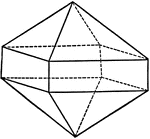
Union of a Pyramid and a Prism of the Same Order
This illustration shows the union of a pyramid and a prism of the same order.
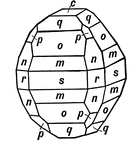
Hydrous Nickel Sulphate
This form shows the planes given on a crystal of hydrous nickel sulphate: the basal pinacoid, (c); three…
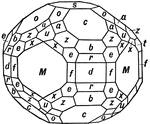
Vesuvianite
This form shows a very complex combination of thirteen tetragonal forms occuring on the mineral Vesuvianite:…

Lead Tungstate
Also known as Stolzite, this crystal is bounded by the unit pyramid of the first order, P, {111} (o),…
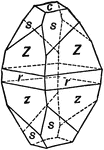
Yttrium Niobate
Also known as Fergusonite, this crystal shows the basal pinacoid, (c); the unit pyramid, (s); and the…
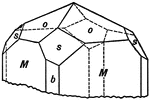
Scapolite
This figure shows a combination of forms sometimes observed on the silicate Scapolite, with the unit…

Calcium Phosphate, Apatite
This crystal of Calcium Phosphate, Apatite, represents a complex combination of hexagonal hemihedral…

Copper Silicate Showing Rhombohedral Tetartohedrism In the Hexagonal System
This is a crystal of Copper Silicate (Dioptase) with a rhombohedron of the third order, (s), in combination…
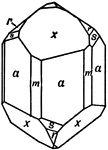
Phenacite
This crystal is mainly terminated by a rhombohedron of the third order, (x). With this form are associated…
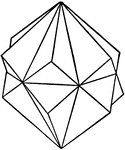
Twin Rhombohedrons
This figure shows two twin rhombohedrons, symmetrical with reference to a prism of the first order,…
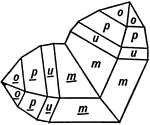
Zircon (Twinning)
In the tetragonal system, the unit pyramid of the second order is the most common twinning plane. This…
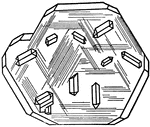
Rutile Growing Upon Titanic Iron
The tetragonal rutile grows upon the rhombohedral titanic iron, so that its prism of the second order,…
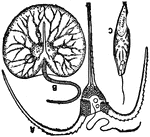
Flagellata
Flagellata is an order of Protozoa characterized by the presence of flagellae (whip-like structures…

Frankincense
Frankincense (Olibanum) is a gum resin obtained from Boswellia Carterii, of the order Burseraceae, and…
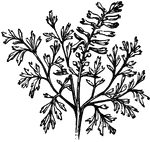
Common Fumitory
Fumitory, or Fumaria, is a genus of herbaceous plants belonging to the order Fumariaceae. The common…
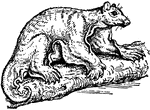
Galeopithecus
Galeopithecus is the generic name of certain mammals from the Malayan region, commonly (incorrectly)…
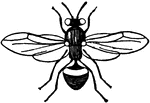
Gall-fly
Gall-fly is a name applied to the members of the family Cynipidae, which are not flies, but are related…
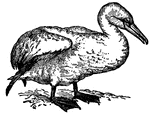
Gannet
Also known as a Solan Goose (Sula bassana), the Gannet is a large marine bird which nests in scattered…
Acipenser Sturio
A type of Ganoid fish. Ganoid is an order of fishes included seven living genera, whose members are…
Amia Occidentalis
A type of Ganoid fish. Ganoid is an order of fishes included seven living genera, whose members are…

Partial Section of Typical Large American Gas Holder
A gas holder is a metallic shell which is open at the bottom (like a bell), the lower edge of which…

Gentian
A genus of hardy plants, Gentians belong to the order Gentianaceae. They have a bitter taste, and one…

Glaux Maritima
Also known as Sea Milkwort, Glaux Maritima is a hardy perennial seashore plant belonging to the order…

Carding Process in the Manufacuring of Jute
After the softening process in the manufacturing of jute, the fibers are about six feet long, and are…

Jute
Jute, also known as Calcutta Hemp, is a fiber obtained from several species of the genus Corchorus of…
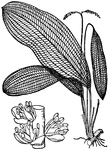
Lattice Leaf
Lattice Leaf is the popular name of a water plant, 'Aponogeton jenestralis', belonging to the order…

Cross of the Legion of Honor
The Cross of the Legion of Honor is a decoration composed of a star of five double rays, with a wreath…

Chrysalis
Typical forms of Chrysalis, the pupae of many Lepidoptera, an order of insects that includes moths and…
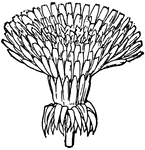
Composite
Composite, or compound flowers, make up the largest botanical order. 1, Capitulum of dandelion.
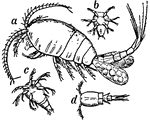
Copepoda
Copepoda, an order of Crustacea. A, cyclops quiadricornis; b, c, d, stages of growth in larvae.
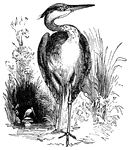
Heron
A great blue heron, commonly found in tropical areas like Florida. They belong to the order Grallatores,…

Gunboats
Gunboats in the James River off the Virginia coast. Gunboats were boats used for carrying one or more…

Spheres of the Ptolemaic System
A diagram showing the order of the universe as expounded by Ptolemy. Its basic concept surmises that…

Jesus Tells the Rich Man to Sell All of His Possessions, Give to the Poor, and Follow Him
"And when Jesus heard it, he said unto him, One thing thou lackest yet: sell all that thou hast, and…

Paul is Beheaded at Rome by the Order of Emperor Nero
Illustration of Paul, kneeling on one knee in the city streets, head bowed, awaiting execution. A man…
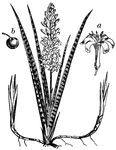
Snake Plant
Sansevieria Zeylanica is the Latin name, but this plant is also called a Mother-in-law's Tongue. "A…

Pulleys - Smeaton's Blocks
"A system of pulleys in two blocks, so arranged that the parts of continuous rope are approximately…